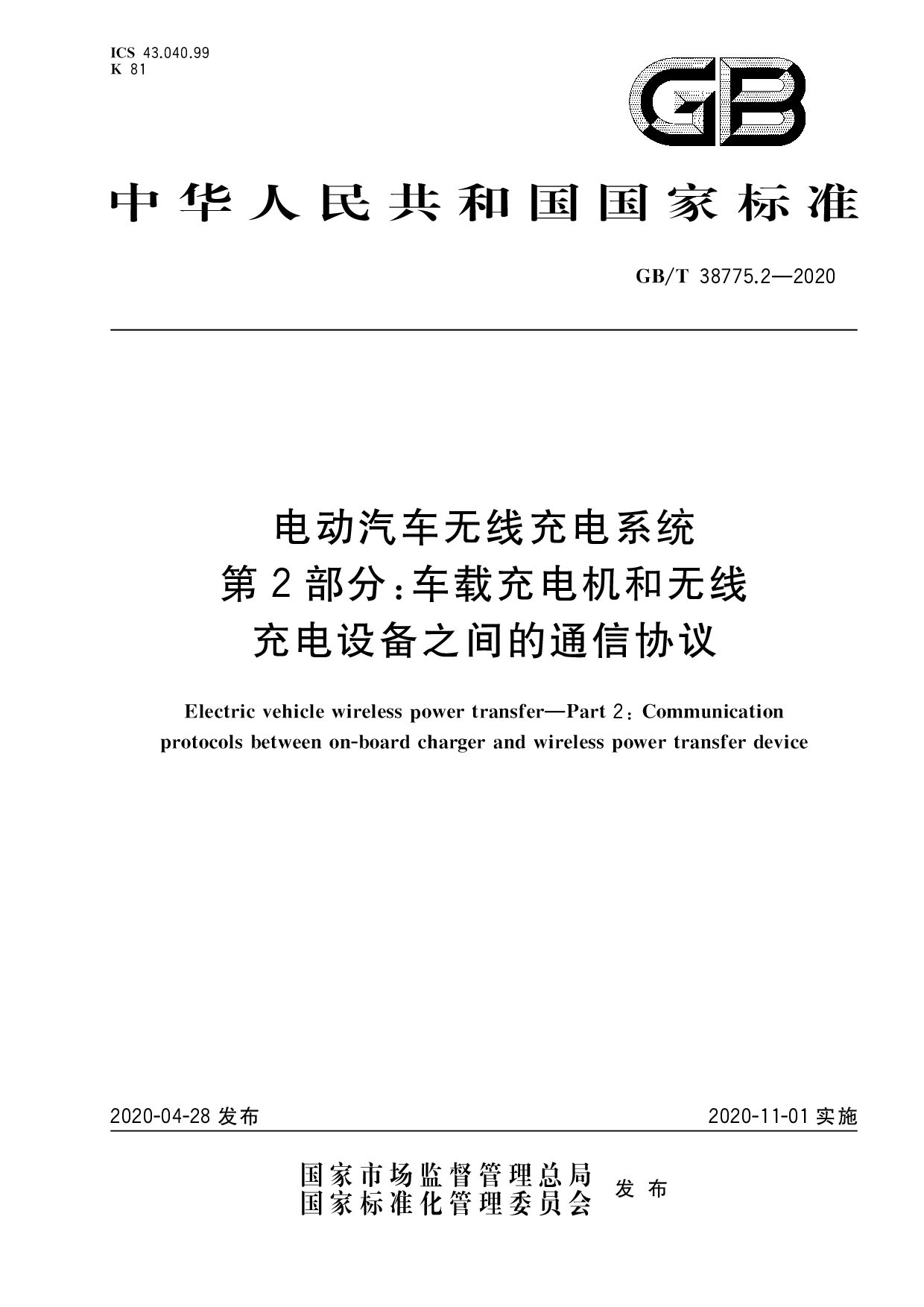GB/T 38775.2-2020
Electric vehicle wireless power transfer—Part 2: Communication protocols between on-board charger and wireless power transfer device (English Version)

- Standard No.
- GB/T 38775.2-2020
- Language
- Chinese, Available in English version
- Release Date
- 2020
- Published By
- General Administration of Quality Supervision, Inspection and Quarantine of the People‘s Republic of China
- Latest
- GB/T 38775.2-2020
- Scope
- This part of GB/T38775 specifies the communication protocol for wireless charging control between the ground communication control unit (CSU) and the in-vehicle communication control unit (IVU) of the static wireless charging system of electric vehicles; it also specifies the wireless charging control management system (WCCMS) Communication protocol involved in wireless charging control. This section applies to the management and control between the ground communication control unit (CSU) and the control management system (WCCMS), and between the in-vehicle communication control unit (IVU) and the ground communication control unit (CSU).
- Introduction
Analysis of the core architecture of the standard
The wireless charging system defined by the standard adopts a layered architecture:
- Ground system: includes WCCMS (control management system), CSU (ground communication unit), PTC (power transmission controller) and other equipment
- Vehicle system: includes IVU (in-vehicle communication unit), PPC (power receiving controller) and other components
Communication mode Participating unit Typical application scenario Mode A CSU↔IVU Private charging pile, basic communication Mode B WCCMS↔CSU↔IVU Public charging station, remote management Key Technical Parameters
Communication Interface Specifications
- CI interface: IEEE 802.11 physical layer protocol is adopted between CSU and IVU
- Keep-alive mechanism: The default timeout detection is 1 minute to ensure connection reliability
Safety Control Requirements
The system must implement a triple protection mechanism:
- Two-way authentication of equipment (digital signature + random number challenge)
- Encrypted transmission of communication data
- Real-time fault monitoring (including 21 types of vehicle system faults and 15 types of ground system fault codes)
Typical communication flow
Charging startup process (mode B)
- IVU registration→CSU→WCCMS
- Interoperability detection (coil matching verification)
- WCCMS issues charging instructions
- PTC activates energy transmission
Exception handling mechanism
Fault type Handling method Response time Communication interruption Automatically stop charging + status reporting ≤60s Liveness detection Immediate termination + fault code 0x21/0x02 Real-time Implementation suggestions
Key points for device development
- CSU should support simultaneous management of multiple PTC devices (the maximum number needs to be configured according to the actual scenario)
- IVU needs to integrate vehicle driving mode detection (OFF/ACC/ON/LOCK status)
Test and verification requirements
It is recommended to verify in stages:
- Protocol consistency test (message format/state machine)
- Interoperability test (networking of devices from different manufacturers)
- Security stress test (simulating malicious attack scenarios)
GB/T 38775.2-2020 Referenced Document
- GB/T 38775.1-2020 Electric vehicle wireless power transfer—Part 1:General requirements
- GB/T 38775.3-2020 Electric vehicle wireless power transfer—Part 3: Specific requirements
GB/T 38775.2-2020 history
- 2020 GB/T 38775.2-2020 Electric vehicle wireless power transfer—Part 2: Communication protocols between on-board charger and wireless power transfer device
GB/T 38775.2-2020 -All Parts
GB/T 38775.1-2020 Electric vehicle wireless power transfer—Part 1:General requirements
GB/T 38775.2-2020 Electric vehicle wireless power transfer—Part 2: Communication protocols between on-board charger and wireless power transfer device
GB/T 38775.3-2020 Electric vehicle wireless power transfer—Part 3: Specific requirements
GB/T 38775.4-2020 Electric vehicle wireless power transfer—Part 4:Limits and test methods of electromagnetic environment
GB/T 38775.5-2021 Electric vehicle wireless power transfer—Part 5: Electromagnetic compatibility requirements and test methods
GB/T 38775.6-2021 Electric vehicle wireless power transfer—Part 6: Interoperability requirements and testing—Gground side
GB/T 38775.7-2021 Electric vehicle wireless power transfer—Part 7:Interoperability requirements and testing—Vehicle side
GB/T 38775.8-2023 Wireless charging systems for electric vehicles Part 8: Special requirements for commercial vehicle applications